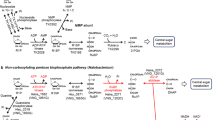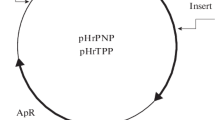Summary
We have isolated and sequenced the gene for a putative NADP-dependent glutamate dehydrogenase from the extremely halophilic archaebacterium Halobacterium salinarium. This gene is transcribed as a unique RNA molecule of about 1700 nucleotides. The 5′end of the transcript contains characteristic consensus transcription initiation and promoter sequences observed in halophilic archaebacteria. The encoded polypeptide, with a predicted length of 435 amino acids, shows significant overall homology and conservation of functional domains when compared with different eubacterial and eukaryotic glutamate dehydrogenases. Surprisingly, the archaebacterial protein shares a larger number of identical amino acid residues with homologous polypeptides from higher eukaryotes than with those from unicellular eukaryotes and eubacteria.
Similar content being viewed by others
References
Austen B, Haberland ME, Smith EL (1980) Secondary structure predictions for the NAD-specific glutamate dehydrogenase of Neurospora crassa. J Biol Chem 225:8001–8004
Baldacci G, Guinet F, Tillit J, Zaccai G, De Recondo AM (1990) Functional implications related to the gene structure of the elongation factor EF-Tu from Halobacterium marismortui. Nucleic Acids Res 18:507–511
Berghöfer B, Kröckel L, Körtner C, Truss M, Schallenberg J, Klein A (1988) Relatedness of archaebacterial RNA polymerase core subunit to their eubacterial and eukaryotic equivalents. Nucleic Acids Res 16:8113–8128
Blanck A, Oesterhelt D (1987) The halo-opsin gene. II. Sequence, primary structure of halorhodopsin and comparison with bacteriorhodopsin. EMBO J 6:265–273
Blumenthal KM, Moon K, Smith EL (1975) Nicotinamide adenine dinucleotide phosphate-specific glutamate dehydrogenase of Neurospora. J Biol Chem 250:3644–3654
Bonete MJ, Camacho ML, Cadenas E (1986) Purification and some properties of NAD+-dependent glutamate dehydrogenase from Halobacterium halobium. Int J Biochem 18:785–789
Bonete MJ, Camacho ML, Cadenas E (1987) A new glutamate dehydrogenase from Halobacterium halobium with different coenzyme specificity. Int J Biochem 19:1149–1155
Bonete MJ, Camacho ML, Cadenas E (1989) Kinetic mechanism of Halobacterium halobium NAD+-glutamate dehydrogenase. Biochim Biophys Acta 990:150–155
Bonete MJ, Camacho ML, Cadenas E (1990) Analysis of the kinetic mechanism of halophilic NADP-dependent glutamate dehydrogenase. Biochim Biophys Acta 1041:305–310
Brett M, Chambers GK, Holder AA, Fincham JRS, Wootton JC (1976) Mutational amino acid replacements in Neurospora crassa NADP-specific glutamate dehydrogenase. J Mol Biol 106:122
Brown JW, Daniels CJ, Reeve JN (1989) Gene structure, organization, and expression in archaebacteria. Crit Rev Microbiol 16:287–338
Chou PY, Fasman GD (1977) β-turns in proteins. J Mol Biol 115:135–175
Conover RK, Doolittle WF (1990) Charcterization of a gene involved in histidine biosynthesis in Halobacterium (Haloferax) volcanii: isolation and rapid mapping by transformation of an auxotroph with cosmid DNA. J Bacteriol 172:3244–3249
Consalvi V, Chiaraluce R, Politi L, Gambacorta A, De Rosa M, Scandurra R (1991) Glutamate dehydrogenase from the thermoacidophilic archaebacterium Sulfolobus solfataricus. Eur J Biochem 196:459–467
Eisenberg H, Wachtel EJ (1987) Structural studies of halophilic proteins, ribosomes, and organelles of bacteria adapted to extreme salt concentrations. Annu Rev Biophys Chem 16:69–92
Gaboriaud C, Bissery V, Benchetrit T, Mornon JP (1987) Hydrophobic cluster analysis: an efficient new way to compare and analyse amino acid sequences. FEBS Lett 224:149–155
Gallwitz D, Sures I (1980) Structure of a split yeast gene: Complete nucleotide sequence of the actin gene in Saccharomyces cerevisiae. Proc Natl Acad Sci USA 77:2546–2550
Garnier J, Osguthorpe DJ, Robson B (1978) Analysis of the accuracy and implications of simple methods for predicting the secondary structure of globular proteins. J Mol Biol 120:97–120
Gough JA, Murray NE (1983) Sequence diversity among related genes for recognition of specific targets in DNA molecules. J Mol Biol 166:1–19
Hawkins AR, Gurr SJ, Montague P, Kinghorn JR (1989) Nucleotide sequence and regulation of expression of the Aspergillus nidulans gdhA gene encoding NADP dependent glutamate dehydrogenase. Mol Gen Genet 218:105–111
Johanningmeier U, Bodner U, Wildner FG (1987) A new mutation in the gene coding for the herbicide-binding protein in chlamydomonas. FEBS Lett 211:221–224
Julliard JH, Smith EL (1979) Partial amino acid sequence of the glutamate dehydrogenase of human liver and a revision of the sequence of the bovine enzyme. J Biol Chem 254:3427–3438
Kinnaird JH, Fincham RS (1983) The complete nucleotide sequence of the Neurospora crassa am (NADP-specific glutamate dehydrogenase) gene. Gene 26:253–260
Lanyi JK (1974) Salt-dependent properties of proteins from extremely halophilic bacteria. Bacteriol Rev 38:272–290
Leicht W, Werber MM, Eisenberg H (1978) Purification and characterization of glutamate dehydrogenase from Halobacterium of the dead sea. Biochemistry 17:4004–4010
Mankin AS, Kagramanova VK (1986) Complete nucleotide sequence of the single ribosomal RNA operon of Halobacterium halobium: secondary structure of the archaebacterial 23S rRNA. Mol Gen Genet 202:152–161
Mattaj IW, McPherson MJ, Wootton SC (1982) Localisation of a strongly conserved section of coding sequence in glutamate dehydrogenase genes. FEBS Lett 147:21–25
McPherson MJ, Wootton JC (1983) Complete nucleotide sequence of the Escherichia coli gdhA gene. Nucleic Acids Res 11: 5257–5266
Mevarech M, Leicht W, Werber MM (1976) Hydrophobic chromatography and fractionation of enzymes from extremely halophilic bacteria using decreasing concentration gradients of ammonium sulfate. Biochemistry 15:2383–2386
Moyes WS, Amuro N, Mohana Rao JK, Zalkin H (1985) Nucleotide sequence of yeast gdh1 encoding nicotinamide adenine dinucleotide phosphate-dependent glutamate dehydrogenase. J Biol Chem 260:8502–8508
Nagasu T, Hall B (1985) Nucleotide sequence of the GDH gene coding for NADP-specific glutamate dehydrogenase of Saccharomyces cerevisiae. Gene 37:247–253
Pearson WR, Lipman DJ (1988) Improved tools for biological sequence comparisons. Proc Natl Acad Sci USA 85:2444–2448
Possot O, Sibold L, Aubert J-P (1989) Nucleotide sequence and expression of the glutamine synthetase structural gene, glnA, of the archaebacterium Methanococcus voltae. Res Microbiol 140:355–371
Reiter WD, Palm P, Zillig W (1988) Analysis of transcription in the archaebacteirum Sulfolobus indicates that archaebacterial promoters are homologous to eukaryotic pol II promoters. Nucleic Acids Res 16:1–19
Sambrook J, Fritsch EF, Maniatis T (1989) Molecular cloning: a laboratory manual. Cold Spring Harbor Laboratory Press, Cold Spring Harbor, New York
Sandman K, Krzycki JA, Dobrinski B, Lurz R, Reeve JN (1990) HMf, a DNA-binding protein from the hyperthermophilic archaeon Methanothermus fervidus, is most closely related to histones. Proc Natl Acad Sci USA 87:5788–5791
Sanger F, Nicklen S, Coulson AR (1977) DNA sequencing with chain-terminating inhibitors. Proc Natl Acad Sci USA 74:5463–5467
Sioud M, Baldacci G, Forterre P, De Recondo AM (1987) Antitumor drugs inhibit the growth of halophilic archaebacteria. Eur J Biochem 169:231–236
Smith EL, Austen BM, Blumenthal KM, Nyc JF (1975) Glutamate dehydrogenases. In: Boyer PD (ed) The enzymes, vol XI. Academic Press, New York, pp 293–367
Woese CR, Kandler O, Wheelis ML (1990) Towards a natural system of organisms: Proposal for the domains Archaea, Bacteria, and Eucarya. Proc Natl Acad Sci USA 87:4576–4579
Wootton JC (1974) The coenzyme-binding domains of glutamate dehydrogenases. Nature 252:542–546
Yanisch-Perron C, Vieira J, Messing J (1985) Improved M13 phage cloning vectors and host strains: nucleotide sequences of the M13mp18 and pUC19 vectors. Gene 33:103–119
Author information
Authors and Affiliations
Additional information
Communicated by W. Goebel
Rights and permissions
About this article
Cite this article
Benachenhou, N., Baldacci, G. The gene for a halophilic glutamate dehydrogenase sequence, transcription analysis and phylogenetic implications. Molec. Gen. Genet. 230, 345–352 (1991). https://doi.org/10.1007/BF00280290
Received:
Issue Date:
DOI: https://doi.org/10.1007/BF00280290




